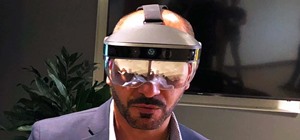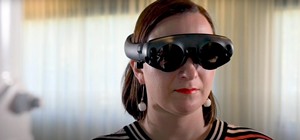
People say that money makes the world go 'round. And it's no different in the world of augmented reality.
If there are any doubts about the future of the AR industry, it doesn't seem like many venture capitalists or corporate investors share those doubts. According to Digi-Capital, investors poured a record $3.6 billion into the space over the last 12 months as of the end of the first quarter of 2018.
In 2017, the top 10 investment rounds in companies working in AR, including component makers, development software platforms, app developers, and headset makers, totaled $1.8 billion. Magic Leap alone has accumulated more than $2 billion to date over its brief history.
- Previous: NR30's Top AR Software Development Leaders to Watch in 2018
- Next Up: NR30's Top AR Influencers to Watch in 2018
So does all this investment activity guarantee that the AR market will be a success? Well, hold on. Let's not forget the infamous burst of the dot-com bubble of the early 2000s. Nevertheless, there's something different about the AR industry.
Investors look for opportunities that give them the best chance for a return on their investment. To that end, the enterprise sector represents the clearest path to AR revenue, as companies are already willing to purchase pricey smartglasses that eschew slick aesthetics for utility in return for efficiency improvements among various job functions.
And while AR wearables have not yet taken off on the consumer side, mobile AR also has its uses cases, particularly for marketing (an indirect revenue generator).
Additionally, the runaway success of Pokémon GO gives developers and investors alike a beacon for financial success via AR gaming. Meanwhile, the companies offering the software tools used to build AR applications are in high demand.
Overall, the investors of the NR30 aren't just providing the financial fuel driving the augmented reality industry; they're also seeding the business world with the underlying framework to support a historic paradigm shift that may scale larger than any tech before it. These early AR investors understand that the time to invest is now before the new AR reality is widely evident to the rest of the investing community.
Without investors, the industry doesn't exist. These are the financiers that are leading the way.
Bob Iger — Disney
Augmented reality isn't what made Bob Iger (pictured in the cover image above) famous. However, his role as chairman and CEO of The Walt Disney Company, arguably the most iconic media company in the world, puts augmented reality in a strong position for mainstream adoption.
A graduate of Ithaca College, Iger has long been named among the most powerful CEOs in business. A large part of his legend is tied to his ability to steer Disney's old-school brand through the modern waters of 21st-century digital media, thus maintaining Disney's storied reputation as one of the most admired and reputable companies in the US.
Under his leadership, Disney has acquired Lucasfilm, Pixar, and Marvel, amassing one of the most formidable content portfolios among media companies. The company's content and distribution universe will only grow stronger through its recent $71 billion acquisition of 21st Century Fox.
When it comes to making all of that intellectual property immersive, Iger has gone on record as preferring augmented reality over virtual reality, especially when it comes to the company's theme parks. Moreover, Iger joined the board of directors at Apple in 2011, where Apple CEO Tim Cook has also frequently stated that he favors AR over VR. Therefore, Iger's preference for AR is likely not a mere coincidence.
Numerous Disney properties have already made their debuts in augmented reality on various platforms, but perhaps the most visible of those experiences is Star Wars: Jedi Challenges, the Lenovo-made headset that brings lightsaber battles and Holochess into the living rooms of Jedi hopefuls. A similar product for Marvel's Avengers is also available.
So when you see your favorite Star Wars, Marvel, Pixar, and Disney characters in augmented reality, you owe thanks to Iger.
These early investments in AR by Iger aren't usually included in widely hailed tech lists of funding rounds for AR startups, but the massive commitment to the technology will ultimately be just as, if not more, impactful than a 100 AR startups paving the path toward mainstream adoption.
With revenues of about $55 billion in 2017, Disney is the 800-pound gorilla of entertainment that can move entire industries in one direction or another. With Iger's bet placed firmly on AR, it's just a matter of time before the rest of the industry falls in line and follows suit.
Tipatat Chennavasin — The Venture Reality Fund
General partner and co-founder at The Venture Reality Fund, Tipatat Chennavasin's contribution to the augmented reality industry comes via financing, specifically for critical early-stage funding that helps startups get their ideas off the ground. The firm kicked off its activities by raising a $50 million fund in 2016.

Chennavasin has first-hand knowledge of the transformative power of immersive computing, crediting virtual reality for helping cure his acrophobia. As such, his firm focuses specifically on funding augmented and virtual reality startups. He also advises startups through incubators and accelerators; he co-founded River, the first VR-focused accelerator program.
Among the firms in his portfolio is 8th Wall, a platform maker that enables developers to extend the capabilities of ARKit and ARCore to unsupported devices. The company has raised $10.4 million in funding over two rounds, with Chennavasin's firm participating in both. Another funded company, VR advertising company Immersv, is poised to extend its platform to AR. In recent months, The Venture Reality Fund has also invested in PLNAR (an AR measurement tool), Virtualitics (data visualizations in augmented reality environments), and Facemoji (camera-driven avatars for live game streaming and video chat).
Over the last few years, Chennavasin has also established himself as an expert in the field of immersive computing, frequently speaking to audiences about how it is changing the technology landscape. Another part of his arsenal comes in the form of The Venture Reality Fund's industry landscape database, where he and his firm track the companies that are developing AR technology or otherwise applying it in their businesses.
Chennavasin earned his undergraduate degree from Stanford University, where he studied human-computer interaction. Later, he applied his knowledge at Rockyou, Reactrix, Penguin Computing, and AGCM Research before founding game developer Big Head Mode.
Last year, extending its international reach, the firm landed new funding from HP Tech Ventures and formed a partnership with Yahoo Japan designed to foster the adoption of AR and VR technologies.
Tom Emrich — Super Ventures
It would be hard to make a case that anyone is doing more to nurture the augmented reality community than Tom Emrich.

Emrich is a founding partner of Super Ventures, the first fund dedicated to augmented reality. Additionally, Emrich is an active investor in general tech startups across various categories and has served as a mentor at the Techstars Toronto Accelerator, Orange Fab, and Chinaccelerator.
His most visible role is as co-producer of the Augmented World Expo, an augmented reality conference that takes place annually in Silicon Valley, Germany, China, and Israel. In its ninth year, AWE attracted more than 6,000 attendees, 400 speakers, and 250 exhibitors for the 2018 edition in Santa Clara.
AWE also hosts AWE Nites, a series of monthly meetups of AR enthusiasts, with chapters established in Toronto, New York, San Francisco, and Chicago. In total, AWE boasts a network of more than 250,000 professionals worldwide. In 2018, We Are Wearables, the tech community that Emrich founded in 2013, was acquired by AWE.
Emrich holds a bachelor's degree in English literature from the University of Waterloo, which he puts to good use by spreading the word about augmented reality and virtual reality via Medium and social media. He has appeared as a speaker at TEDx, SXSW, and TechCrunch Disrupt, and he has also served as an expert source for technology pieces for The New York Times, The Huffington Post, CNN, and the BBC, among others.
We spoke to Emrich about his views on the past and future of AR. Below are his lightly edited responses.
What is your favorite movie depicting the future of AR or VR?
I would say Blade Runner 2049, mostly because I found it refreshing that the movie had no evident focus on eyewear (outside of one VR and drone scene), but instead featured a future facilitated mostly through projection augmented reality. I love this idea of a world filled with holograms, although I am still scratching my head at (SPOILER ALERT) the "magical device" which allowed Joi the hologram to start to live outside of the range of a projector.
When was the moment you knew AR was the future?
It was definitely when I became one of 10 Google Glass Explorers in Canada back in 2013, which I wore for almost two years. One of the biggest reasons I can't wait for head-worn AR is to help me remember things — faces especially. While Google banned facial recognition for Glass, there was a great app called Refresh which would link to your social networks and calendar and serve up dossiers about people you were about to meet right before your meeting to help you look like a superstar. Being served relevant, timely information at eye-level to help me skip past small talk and get into a more meaningful conversation straight away was just one of many special moments with Glass that convinced me that this was the future.
What's the most important thing that happened in AR in the last 12 months?
It is most definitely the unanimous decision by all of the tech giants that AR is the next disruptive wave of computing demonstrated by the rollout of developer and creator tools equipping this critical group to get started building AR solutions today for a device that is already in everyone's hands — the smartphone. Of course, I am talking about Apple's ARKit and Google's ARCore, as well as developer solutions from Facebook, Snap, Amazon, Adobe, Unity, and more. Not to mention some killer startups that have created tools to help build, analyze and monetize AR content.
Peter Rojas — Betaworks Ventures
Like many of the leading players in the relatively new crypto and blockchain space, Peter Rojas comes to the AR startup world from an unlikely background: media. Best known as the co-founder and first editor of Gizmodo in 2002 (the dawn of the blog era), Rojas later went on to co-found and edit Engadget, as well as several other content-focused media websites before joining AOL as vice president of strategy in 2013.

Today, Rojas is a partner at Betaworks Ventures (an investor in Giphy, Product Hunt, Medium, Kickstarter, Tumblr, and others), where he devotes a large amount of his focus to AR startups.
Earlier this year, Betaworks Ventures launched Visioncamp, a startup accelerator event focused on providing funding to new companies and ideas involving augmented reality, computer vision, and "camera-first products and services." Some of the firm's latest AR investments include 8th Wall, Camera IQ, and Streem.
Although Rojas and the Betaworks Ventures team have yet to claim a significant AR breakout hit, it's early days in the space. The kind of seed-stage investment and community building they're fostering will be vital to ensuring that the future of AR isn't governed just by the major players (Apple, Facebook, Google, Microsoft, and others), but by a vibrant ecosystem of smaller AR startups building things that bigger companies haven't even considered yet.
By leading the early charge to help blogs transcend commercial media, Rojas has already helped to mainstream one sector of the tech world that was once thought to be a permanent niche category, only fit for hobbyists. Now, he's tackling a similar mission by identifying and supporting the AR startups that will shape the future of computing for decades to come.
We asked Rojas for his inspiration for moving into a new technology space well as his current take on AR. Below are his lightly edited responses.
The moment you knew AR was the future?
Does the HoloChess scene in Star Wars count as AR? Because when I saw that as a kid it made me realize how we could use technology to enhance and transform the world around us.
The thing you dislike most about currently available AR hardware or software?
I'm realistic about how difficult it is to build AR hardware, so while it's tempting to gripe about things like the narrow FOV on headsets like the HoloLens, the reality is that it just takes time for the industry to progress, and eventually we'll get to where we want to be. It's like complaining in 2007 that the pixel density on smartphone screens is too low. Gotta be patient!
On the other hand, I have been disappointed that we haven't seen more experimentation when it comes to mobile AR games and apps. We have this entirely new spatial dimension to play with, and most developers are not taking advantage of it to explore what new kinds of user experiences can be created. I know it will take time — it took time with mobile, too — but I'd love to see more risk-taking here.
If you were making the overall NR30 list, who would you include on it?
Allison Wood of Camera IQ.
What's the most important thing that happened in AR in the last 12 months.
The launch of ARKit with iOS 11.
Adario Strange and Tommy Palladino contributed to this report.
Just updated your iPhone? You'll find new emoji, enhanced security, podcast transcripts, Apple Cash virtual numbers, and other useful features. There are even new additions hidden within Safari. Find out what's new and changed on your iPhone with the iOS 17.4 update.

























Be the First to Comment
Share Your Thoughts